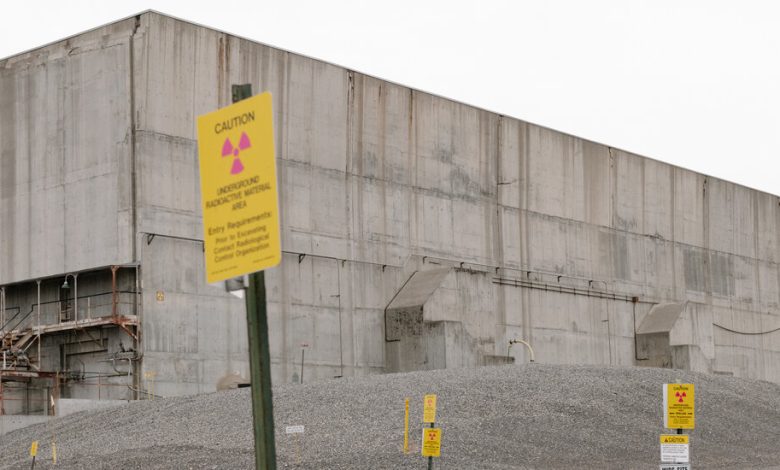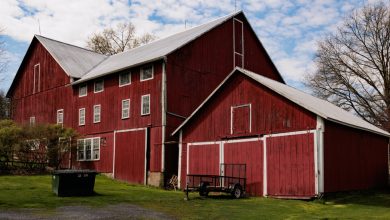A Poisonous Cold War Legacy That Defies a Solution

From 1950 to 1990, the U.S. Energy Department produced an average of four nuclear bombs every day, turning them out of hastily built factories with few environmental safeguards that left behind a vast legacy of toxic radioactive waste.
Nowhere were the problems greater than at the Hanford Site in Washington State, where engineers sent to clean up the mess after the Cold War discovered 54 million gallons of highly radioactive sludge left from producing the plutonium in America’s atomic bombs, including the one dropped on the Japanese city of Nagasaki in 1945.
Cleaning out the underground tanks that were leaching poisonous waste toward the Columbia River just six miles away and somehow stabilizing it for permanent disposal presented one of the most complex chemical problems ever encountered. Engineers thought they had solved it years ago with an elaborate plan to pump out the sludge, embed it in glass and deposit it deep in the mountains of the Nevada desert.

A site diagram for what was known as the Hanford Engineer Works, established in Washington State as part of the Manhattan Project, when plutonium production was underway in 1945.Credit…U.S. Army Signal Corps/PhotoQuest, via Getty Images
But construction of a five-story, 137,000 square-foot chemical treatment plant for the task was halted in 2012 — after an expenditure of $4 billion — when it was found to be riddled with safety defects. The naked superstructure of the plant has stood in mothballs for 11 years, a potent symbol of the nation’s failure, nearly 80 years after the Second World War, to deal decisively with the atomic era’s deadliest legacy.
The cleanup at Hanford is now at an inflection point. The Energy Department has been in closed-door negotiations with state officials and the U.S. Environmental Protection Agency, trying to revamp the plan. But many fear the most likely compromises, which could be announced in the coming months, will put the speed and quality of the cleanup at risk.
The government now appears to be seriously evaluating the need to leave thousands of gallons of leftover waste buried forever in Hanford’s shallow underground tanks, according to some of those familiar with the negotiations, and protect some of the waste not in impenetrable glass, but in a concrete grout casing that would almost certainly decay thousands of years before the toxic materials that it is designed to hold at bay.
“The Energy Department is coming to a big crossroads,” said Thomas Grumbly, a former assistant secretary at the department who oversaw the early days of the project during the Clinton administration.
Successive energy secretaries over the last 30 years, he said, “have slammed their heads against the wall” to come up with a technology and budget that would make the problem go away not only at Hanford, but also at other nuclear weapons sites around the country.
Plants in South Carolina, Washington, Ohio and Idaho that helped produce more than 60,000 atomic bombs have tons of radioactive debris that will be radioactive for thousands of years. And unlike nuclear power plants, whose waste consists of dry uranium pellets locked away in metal tubes, the weapons facilities are dealing with millions of gallons of a peanut butter-like sludge stored in aging underground tanks.
Two million pounds of mercury remain in the soils and waters of eastern Tennessee. Radioactive plumes are contaminating the Great Miami aquifer near Cincinnati.
At site after site, the solution has come down to a choice between an expensive, decades-long cleanup or quicker action that leaves a large amount of waste in place.
Hanford, some 580 square miles of shrub-steppe desert in south-central Washington State, is the largest and most contaminated of all the weapons production sites — too polluted to ever be returned to public use. But the problem is urgent, given the risk of radionuclides contaminating the Columbia River, a vital lifeline for cities, farms, tribes and wildlife in two states.
The search for a solution has dragged on so long that there is pressure to produce some result for all the massive spending, even if it does not meet past expectations. That could mark a dramatic retreat from longstanding promises to nearby residents — who experienced thyroid, reproductive and nervous system tumors linked by researchers to exposure during the era of plutonium production — that the government would adhere to the highest possible cleanup standards.
The negotiations between federal and state officials have involved stretching out the cleanup schedule and using grout instead of glass to stabilize about half of the low-level radioactive waste taken from the site, as well as thousands of gallons of waste stuck in the tanks when the rest of the high-level waste is removed.
The potential for a compromise that would allow some of that waste to remain in the bottom of the tanks has set off sharp disagreements among experts: Some say using grout to encase it would be a scientifically safe, economical solution. Critics warn that the waste could outlive the grout and seep out again in future centuries.
Energy Department officials say that any plan adopted will be sufficient to render the site safe for future generations and that any waste left behind would pose no threat to human health.
Brian Vance, a former Navy submarine captain who is the department’s site manager at Hanford, said the original expectations ran into formidable scientific and financial obstacles. He said engineers were trying to find a solution that was both safe and possible.
“If you think about the decisions made in the 1990s, the project plan was quite a bit different,” he said. It required unproven technology that was “easy to make on the drawing board, but hard to make as you progress and see the realities.”
Mr. Grumbly said he presented the Clinton administration years ago with budget estimatesof hundreds of billions of dollars to clean up former nuclear weapons sites around the country. Officials at the Office of Management and Budget told him “to never show them publicly,” he recalled.
“They have under-prioritized it,” he said of the federal government, noting that even now, the Biden administration had not nominated an assistant secretary to oversee the cleanup.
As it stands, the job of treating the tank waste at Hanford alone carries an official price tag of up to $528 billion; at the current rate of spending, it could take centuries to budget and finish the project.
Congress sent about $2.8 billion this year to the site, with about $1.7 billion allocated to cleaning up the tanks. But there has been relatively little real progress.
Gary Brunson, the Energy Department’s former engineering director at the waste treatment plant, said the cleanup had been a failure. He and two other technical managers filed a whistle-blower suit in 2013 against the chief cleanup contractor, Bechtel and its partner, accusing the company of doing defective work and then illegally lobbying for budget increases. The suit was joined by the Justice Department and settled in 2016 for $125 million.
Putting a focus on treating less dangerous, low-level waste faster would be part of a significant retreat in the mission, in Mr. Brunson’s view.
“The whole purpose of that plant was to treat the high-level waste,” he said. “They couldn’t do that so they are treating low-level waste. They don’t have a comprehensive plan, so they are making up these interim goals.”
The original architecture for immobilizing the tank waste was to chemically separate it, using the now-mothballed treatment plant, into low and high radioactive streams. Then, two separate melter plants — human-made volcanoes that operate at the temperature of lava — would encase both in glass.
But precisely how to do that safely has proved elusive.
“They have built one of the most complex mousetraps in the world,” Mr. Brunson said. “It will never work.”
The reality, he said, is that the 54 million gallons of sludge will most likely never be removed; he believes it will be grouted and left in place for future generations to deal with.
Construction of the chemical treatment plant was stopped by former President Barack Obama’s energy secretary, Steven Chu, amid allegations that the process could lead to explosions of hydrogen gas and spontaneous nuclear fission.
The U.S. Government Accountability Office has recommended abandoning the plant, owing to the costs of ever making it work. “We could build an elevator to the moon. I would put the pre-treatment plant in the same category,” said Nathan Anderson, a director of the G.A.O.’s environmental team.
Then comes the issue of permanently stabilizing the waste. Almost no one disagrees that the most dangerous high-level waste must be encased in glass and buried in a geologically stable repository such as Yucca Mountain in Nevada, a site that for decades has been politically off the table.
But what to do with the lower-level wastes is less certain, and that is an important part of the current negotiations. The G.A.O. concluded that grouting much of it would be just as environmentally safe as putting it in glass, get the job done faster, save billions of dollars and pose a lower risk of an industrial accident.
But the Washington Department of Ecology’s Hanford project manager, David Bowen, considers it a safety risk and wants it shipped out of state.
There are even bigger stakes in dealing with the high-level waste.
Even though most of it will be vitrified, engineers estimate that up to 1 percent of the radioactive sludge could be left behind when most of the waste is removed, according to Energy Department documents and state officials.
Energy officials say that radioactivity levels of any residual waste would be relatively low, and that grout would prevent the tanks from collapsing as they rust.
But the total waste left behind could be in the hundreds of thousands of gallons, and critics say it could be highly dangerous.
“The closer you get to the bottom of those tanks, the more radioactive, toxic and dangerous waste is,” said Geoffrey Fettus, a lawyer with the Natural Resources Defense Council, which has sued the government over the Hanford cleanup.
“We would oppose it,” said Nikolas Peterson, executive director of the watchdog group Hanford Challenge, which has long pushed for a safe resolution.
There has been some progress. Cleanup workers have demolished contaminated buildings, cleansed soil along the Columbia and stabilized seven reactors that made plutonium.
But around central Washington, an area that is home to the state’s famous grape vineyards and apple orchards, there is a growing sense of impatience.
Leaders of the Yakama Nation, an 11,000-member tribe whose ancestral lands once included the Hanford site, say their 1855 treaty promised that tribe members would have the right to hunt and fish on healthy lands.
“Before the Manhattan Project, there was a handshake agreement that this area would be returned to the way it was,” said Trina Sherwood, a cultural specialist in the tribe’s natural resources department. “How can we agree to leave the poison in the land?”
Yet returning the land to what it once was is an outcome that almost no one expects.
“There are parts of the site that will never be turned over,” Mr. Vance, the Hanford site manager, said. “We are going to be here a long time.”



